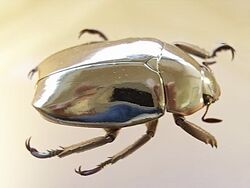Biology:Chrysina limbata
| Chrysina limbata | |
|---|---|

| |
| Scientific classification | |
| Domain: | Eukaryota |
| Kingdom: | Animalia |
| Phylum: | Arthropoda |
| Class: | Insecta |
| Order: | Coleoptera |
| Family: | Scarabaeidae |
| Subfamily: | Rutelinae |
| Tribe: | Rutelini |
| Genus: | Chrysina |
| Species: | C. limbata
|
| Binomial name | |
| Chrysina limbata (Rothschild & Jordan, 1894)
| |
| Synonyms[1] | |
| |
Chrysina limbata is a species of scarab beetle found only in mid-altitude forests in Costa Rica and western Panama.[2][3] It is in the genus Chrysina, in the subfamily Rutelinae (shining leaf chafers).[4] It is notable for its metallic reflective silver color.[2]
Taxonomy
Chrysina limbata was described in 1894 by zoologists Walter Rothschild and Karl Jordan, initially as Plusiotis limbata - Plusiotis being a synonym of Chrysina.[5] C. limbata is in the superfamily Scarabaeoidea, family Scarabaeidae, subfamily Rutelinae and tribe Rutelini.[6][7][8][9]
Description
Adult C. limbata measure between 24 and 29 mm (0.94–1.14 in) in length.[2] They have a reflective silver metallic appearance which is achieved through thin film interference within layers of chitin. These layers of the chitin coating are chirped (in layers of differing thicknesses), forming a complex multilayer as each layer decreases in depth; as the thickness changes, so too does the optical path-length. Each chirped layer is tuned to a different wavelength of light. The multilayer found on C. limbata reflects close to 97% of light across the visible wavelength range.[10][11]
Physicist William E. Vargas believes that the metallic appearance may act like water, appearing only as a bright spot to predators. The rain forest of Costa Rica where C. limbata lives has water suspended from leaves at ground level. Light is refracted in different directions, and it allows metallic beetles to fool predators.[12]
Life history
Only the adult beetle stage of Chrysina limbata is known; its immature stages are entirely unknown.[2] Like all beetles, scarabs go through a metamorphosis. The life cycle begins when the female lays an egg, which becomes a larva, then a c-shaped pupa, which becomes an adult. The scarab beetles lay their eggs in the ground or in decomposing materials. Larvae feed on plant roots or rotting matter.[13]
References
- ↑ "Chrysina limbata". Species. GBIF. http://www.gbif.org/species/5989935.
- ↑ 2.0 2.1 2.2 2.3 Barria, M.D. (2023). A Monographic Revision of The Jewel Scarabs Genus Chrysina from Panama, Colombia, and Ecuador (Coleoptera: Scarabaeidae: Rutelinae: Rutelini). Zea Books, University of Nebraska-Lincoln Libraries. pp. 49–51, 76. doi:10.32873/unl.dc.zea.1345. ISBN 978-1-60962-286-2.
- ↑ "Chrysina limbata (Rothschild & Jordan)". Generic Guide to New World Scarab Beetles. University of Nebraska-Lincoln State Museum - Division of Entomology. https://unsm-ento.unl.edu/Guide/Scarabaeoidea/Scarabaeidae/Rutelinae/Rutelinae-Tribes/Rutelini/Chrysina/Chrysina-species/C-limbata/Climbata.html.
- ↑ "Shining leaf chafer" (in en). Encyclopedia Britannica. https://www.britannica.com/animal/shining-leaf-chafer. Retrieved 2012-06-23.
- ↑ Rothschild, Walter; Jordan, Karl (January 1894). "Novitates zoologicae : a journal of zoology in connection with the Tring Museum". Novitates Zoologicae 1 (1): 505. https://www.biodiversitylibrary.org/page/3857779#page/542/mode/1up. Retrieved 24 June 2022.
- ↑ Thomas, Donald B.; Hawks, Dave; Robacker, Dave (18 May 2006). "Chrysina limbata (Rothschild & Jordan)". University of Nebraska-Lincoln State Museum – Division of Entomology. https://unsm-ento.unl.edu/Guide/Scarabaeoidea/Scarabaeidae/Rutelinae/Rutelinae-Tribes/Rutelini/Chrysina/Chrysina-species/C-limbata/Climbata.html.
- ↑ Thomas, Michael C. (2017). American Beetles, Volume II: Polyphaga: Scarabaeoidea through Curculionoidea (1st ed.). CRC Press. p. 63. ISBN 978-1138423701. https://books.google.com/books?id=YiPNBQAAQBAJ&dq=Chrysina+Kirby+genus+Chrysina&pg=PA63. Retrieved 24 June 2022.
- ↑ "Genus Chrysina". Iowas State University Department of Entomology. https://bugguide.net/node/view/6604.
- ↑ Schmitt, Michael; Rönn, Thomas (21 December 2011). "Types of geographical distribution of leaf beetles (Chrysomelidae) in Central Europe". ZooKeys (157): 131–158. doi:10.3897/zookeys.157.1798. PMID 22303107. PMC 3253646. https://www.researchgate.net/figure/Distribution-map-of-Chrysolina-limbata-based-on-47-records-for-the-species-and-4814_fig10_221803819. Retrieved 24 June 2022.
- ↑ Greanya, Viktoria (2015). Bioinspired Photonics : Optical Structures and Systems Inspired by Nature.. Boca Raton: CRC Press. pp. 46–49. ISBN 978-1466504028. https://books.google.com/books?id=aMwdCgAAQBAJ&dq=Chrysina+limbata&pg=PA48. Retrieved 24 June 2022.
- ↑ Campos-Fernández, Cristian; Azofeifa, Daniel E.; Hernández-Jiménez, Marcela; Ruiz-Ruiz, Adams; Vargas, William E. (1 May 2011). "Visible light reflection spectra from cuticle layered materials". Optical Materials Express 1 (1): 85. doi:10.1364/OME.1.000085. Bibcode: 2011OMExp...1...85C. https://www.researchgate.net/figure/Pictures-of-the-Chrysina-aurigans-left-and-the-Chrysina-limbata-right-beetle_fig1_249650651. Retrieved 24 June 2022.
- ↑ "Beetle bling: Researchers discover optical secrets of 'metallic' beetles". Optical Society of America. Science Daily. 25 April 2011. https://www.sciencedaily.com/releases/2011/04/110425120344.htm.
- ↑ Hadley, Debbie. "Discover Scarab Beetles and Family Scarabaeidae". https://www.thoughtco.com/scarab-beetles-family-scarabaeidae-1968149.
Wikidata ☰ Q14899251 entry
 |

